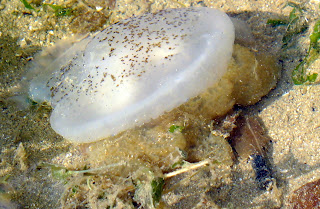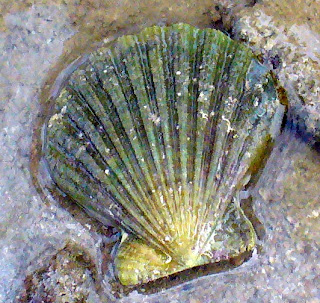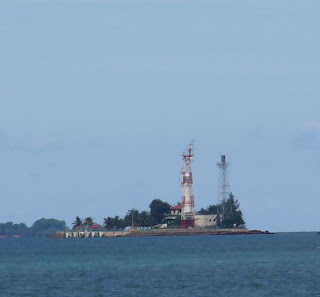(Entry @ 22 May 2007, Got ID for second 'discovery', confirmation of ID for Eleventh 'discovery' and change of info for Chek Jawa)
(Entry @ late night on 20 May 2007, change of ID for seventh 'discovery')
Changi Beach, was feeling excited as it was my first time exploring the northern shores of Singapore for inter-tidal life.
Although i arrived a little late together with two of my friends, we still managed to make it in time to view the sun rise in progress (picture below), looking at it really makes up for the lack of sleep due to the early hour we needed to wake up for this trip.
 As we munched our breakfast as walking towards the shoreline looking for Samson and Luan Keng, the sight of the amount of seagrass and seaweeds present really made me stare in awe for one sec.
As we munched our breakfast as walking towards the shoreline looking for Samson and Luan Keng, the sight of the amount of seagrass and seaweeds present really made me stare in awe for one sec.Once we approached Samson and Luan Keng, they were looking at a stripped hermit crab which occupied a shell that was at least 15cm in length.
First 'discovery'! (picture below)
 Discovery Note:
Discovery Note:1. Hermit crabs have a long, soft abdomen.
2. So without a shell to protect it, the hermit crab is vulnerable to predators and to drying out.
3. Hermit crabs have four pairs of legs, the first two pairs are walking legs which we will usually see and the last two pairs of legs are used to tightly grab the shell which is their home.
Second 'discovery' (picture below) looks like a fan shell, i'm still not too sure, could anyone help me to ID this? Thanks =)
(Entry @ 22 May 2007: This (picture below) is a fan shell. Thanks, Ron, for helping me to ID it)
 Discovery Note (Entry @ 22 May 2007):
Discovery Note (Entry @ 22 May 2007):1. They are usually buried in the sand with only the boarder edge sticking out.
2. The fan shell was once plentiful in Singapore but now threaten due to the loss of habitats and human collection.
Third 'discovery' was a carpet anemone (picture below), there seem to be quite a number of them along the inter-tidal zone we explored. Throughout the walk, i counted about 8 of them and sighted several baby anemones also.

Discovery Note:
1. You can see the short, sticky tentacles covering the oral disk like structure. We can find stinging cells in these tentacles.
2. These stinging cells are used to gather food, paralyse prey and defend against predators, rivals and itchy hands. So don’t touch them with your naked hands!
 Underside of the Sand star (picture below),
Underside of the Sand star (picture below),
Discovery Note:
1. The tube feet of sand stars end in points instead of suckers.
2. These pointed tube feet push down powerfully allowing Sand star to ‘race’ rapidly over the sand.
A fruit for thought, would these people mind if someone 'takes' them away from their home and put them into another place/country or into captivity?
I took the picture below to document the amount of sea grass found on the inter-tidal zone and notice the 'small' people in the picture, they are the people i was talking about.
 Anyway, back to the discoveries, fifth 'discovery' was a moon crab (picture below).
Anyway, back to the discoveries, fifth 'discovery' was a moon crab (picture below).
Discovery Note:
1. Instead of the usual walking legs we see on crabs, all four pairs of legs of the moon crab are paddle like.
2. This helps the crab to swim and used as spades to quickly bury themselves into the sand.
Sixth 'discovery' was a geographic Sea Hare (picture below), something i saw for the first time!

Discovery Note:
1. They are often overlooked as their appearance enables them to blend in with the seaweeds or they may lie buried in the sand.
2. They can swim by flapping the sides of its body.
(Entry @ late 20 May 07, this is a swimming anemone. Thanks, Ria, for spotting the mistake i made)

Discovery Note (according to Ria):
1. This anemone often looks like a ball of tentacles and it doesn't have a long body column that is buried in the ground like the carpet anemones or peacock anemones.
2. Instead, it may be perched on seagrasess. This anemone can swim by undulating its tentacles!
 Discovery Note:
Discovery Note:1. Difficult to spot due to its translucent appearance (can you spot the anemone shrimp in the picture above?)
2. They are able to live in anemones just like clown fishes.
3. The anemone shrimp and the anemone share a symbiotic relationship of mutualism, the shrimp attracts prey to the anemone for food while the anemone provides the shrimp with a shelter.
Ninth 'discovery' (picture below) was a row of hermit crabs lining up. What are they doing? Make a guess before reading on...
 Discovery Note:
Discovery Note:1. As a hermit crab grows bigger, it has to move out of its shell and move into a bigger one.
2. The hermit crab was testing the big shell on the right as it needs to move and it seems that there are two more hermit crabs waiting in line to move into bigger shells also.
3. So hermit crabs actually practiced 'upgrading' and 'queuing' long before Singaporeans =)
4. So don't remove any shells you find on any shores, as they may be potential homes for hermit crabs.
Notice the eyes on long stalks for the stripped hermit crab (picture below),
 Tenth 'discovery' was a mantis shrimp (picture below), spotted by my friend. Another first sighting of this animal for me.
Tenth 'discovery' was a mantis shrimp (picture below), spotted by my friend. Another first sighting of this animal for me. Discovery Note:
Discovery Note:1. They are neither shrimps or mantis, actually they receive their name purely from the physical resemblance to both the terrestrial praying mantis and shrimp.
2. They have powerful claws which they use to attack and kill prey by spearing, stunning or dismemberment.
3. Their claws are so powerful that it was recorded that a double paned aquarium glass was broken with a single strike from the claw of a mantis shrimp. So don't touch it with your bare hands!
Eleventh 'discovery' was an unknown creature, it looked like a sea slug to me.
 Note:
Note:Thanks to Ron who pointed out to me during lunch that this is actually a hairy sea hare (correct?), if my memory serves me correct. =P
(Entry @ 22 May 2007: Ron have confirmed that my memory is correct for this, it's a hairy sea hare.)
Twelfth 'discovery' was a pipe fish (picture below), spotted by my friend again. She's really a good spotter!
 Discovery Note:
Discovery Note:1. Pipe fishes belong to the same family as the seahorses and have similar practices and diet.
2. Like the seahorse, the male pipe fish carries the eggs.
3. Pipe fishes lack a pouch, so the eggs are glued to the underside of a male's tail or abdomen.
Thirteenth 'discovery' was a find by Samson, a ball sea cucumber (picture below).
 Discovery Note:
Discovery Note:1. They are seldom seen as they are buried beneath the sand.
2. They are sometimes washed ashore among piles of seaweeds, so try not to step on seaweeds during inter-tidal walks or keep your eyes wide open. And remember to put them gently into a pool of water if you see an exposed ball sea cucumber.
Fourteenth 'discovery' was a jellyfish (pictures below),

 Discovery Note:
Discovery Note:1. Jellyfishes actually do not biologically qualify as 'fishes', so the term 'jellyfish' is actually a misnomer for some. You could call them 'jellies' or sea jelly' instead. Very much like the case for starfishes.
2. Sea Jellies possesses tentacles that have stinging cells which sting or kill other animals. Most jellies use them to secure prey or as a defense mechanism. So DON't ever touch a jelly with your naked hand.
As the sun rose higher into the sun, the tide slowly rose to cover the inter-tidal zone and we had to stop our enjoyable exploration due to that. Picture of tide rising (below).
 It was really a morning of discoveries and i would like to thank Samson for organising this trip, Luan Keng and Samson for pointing out things i didn't know about, Luan Keng's niece who actually saw more than 10 things (not sure if she knew that or not =P) and my two friends who joined us.
It was really a morning of discoveries and i would like to thank Samson for organising this trip, Luan Keng and Samson for pointing out things i didn't know about, Luan Keng's niece who actually saw more than 10 things (not sure if she knew that or not =P) and my two friends who joined us.Note:
Discovers may also visit Samson's blog on the visit at Changi Beach.
Last Note:
Heard from Ron that things in Chek Jawa is almost back to how it looked like before the heavy rains in Jan which 'killed' a lot of life there (Entry @ 22 May 2007: Only applies to the deeper end of the coral rubble area. Thanks, Ron for correcting my memory =>). Hope that Chek Jawa will 'recover' and be reopened for the public to visit and learn about the importance of leaving some things alone as it is and not eating them as food or taking them away from their homes.







































